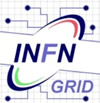Geneva and Rome, 1 December 2004. In the presence of Minister Letizia Moratti, CERN1 Director General, Robert Aymar has presented the Italian National Institute for Nuclear Physics2 (INFN) with an award to recognize its contributions to developing computational Grids, and its pioneering efforts to establish and promote Grid technology at the national level and in Europe. The award was presented to Roberto Petronzio, President of INFN, during a ceremony that took place in Rome, at the seat of Ministry of Education, University and Research.
Geneva and Rome, 1 December 2004. In the presence of Minister Letizia Moratti, CERN1 Director General, Robert Aymar has presented the Italian National Institute for Nuclear Physics2 (INFN) with an award to recognize its contributions to developing computational Grids, and its pioneering efforts to establish and promote Grid technology at the national level and in Europe. The award was presented to Roberto Petronzio, President of INFN, during a ceremony that took place in Rome, at the seat of Ministry of Education, University and Research.
"This award to INFN has a high symbolic meaning", said Minister Moratti, "because it highlights the exceptional results reached up to now, in addition to looking to the future and at the next steps for the realization of the project".
"The INFN Grid Project", added Minister Moratti, "counts more than 20 sites at the most important Italian universities and, although primarily focused on the development of computing infrastructures for physics, it has been open to other fields of research, such as bio-medicine and earth observation, and to industry, from the beginning. It represents a successful example of collaboration between physicists, software engineers, computer professionals, computer scientists and Italian industries."
Grid technology is considered an important breakthrough in computer networking developments. This technology enables services for sharing the resources of an interconnected worldwide network of tens of thousands of computers and storage devices. Indeed, the Grid goes well beyond simple communication between computers: it aims ultimately to turn the global network of computers into one single vast computational resource. This is a big step forward compared to Web technology, which allows information to be shared over the internet.
"INFN has always been at the forefront of computing technology developments," said Robert Aymar, "and understood the potential of the Grid concept and technology in the field of High Energy Physics (HEP) very early on. It has pushed the Grid as a general solution for HEP computing and is also actively bringing Grid technology to other areas."
As one of the first major national Grid initiatives in Europe, the INFN Grid project was launched in 1999. The objective was to investigate the potential of Grid software for High Energy Physics applications.
In 2001, the European DataGrid project (EDG) was born. It was the largest European Grid project in the 5th EU Framework Programme for Research and Technological Development, with INFN taking a leading role in Grid Workload Management. INFN also participated in the European DataTAG project pushing the limits of high-speed data transfer across the Atlantic. These developments have been successfully applied in the LHC Computing Grid project (LCG). INFN is one of the main partners of LCG. The goal of the project is to deploy a worldwide computational Grid service able to analyse the tremendous amounts of data that will be produced by the LHC starting in 2007 – more than 15 Petabytes a year or the equivalent of several million DVDs.
"INFN is honoured to receive this CERN award. Our institute played a crucial and visionary role in the early days of Grid technology development for the HEP community", said Roberto Petronzio. "I have no doubt that the new developments for LCG will prove to be of great value to the success of the LHC project, and the wider application of the computing Grid in science and industry."
With CERN as lead partner and with the collaboration of other institutes from almost all European countries, INFN has promoted the new EGEE (Enabling Grids for E-sciencE) project that started on 1 April 2004. The primary goal of this project is to create a seamless international Grid infrastructure for the support of the wide research community. This is the largest scientific infrastructure project that the EU has ever undertaken and it involves many partner institutions in Europe, the United States, Russia and Asia.
For further information:
Barbara Gallavotti, Head of INFN Communications Office,
Barbara.Gallavotti@Presid.infn.it, Tel:+39-06-686-8162 / +39-335-660-6075
François Grey, IT Communications Team, CERN IT Department,
Francois.Grey@cern.ch, Tel: +41 22 767 1483
At present, CERN's Member States are Austria, Belgium, Bulgaria, the Czech Republic, Denmark, Finland, France, Germany, Greece, Hungary, Italy, the Netherlands, Norway, Poland, Portugal, the Slovak Republic, Spain, Sweden, Switzerland and the United Kingdom. India, Israel, Japan, the Russian Federation, the United States of America, Turkey, the European Commission and UNESCO have Observer status.
2. INFN, the Italian National Institute for Nuclear Physics, is the body that promotes, coordinates and carries out research in the field of nuclear and elementary particles physics, as well as the technological research necessary for such sectors. Research activities are organized in national groups and span many disciplines: semiconductor physics, electronics, superconductivity, and information technology. Since most INFN resources are devoted to basic experimental research in subnuclear and nuclear physics, the processing of data has always been one of the most important and demanding research functions at INFN.

